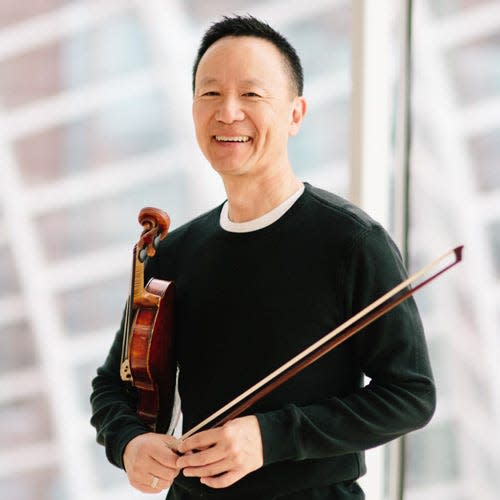Two masterworks highlight Adrian Symphony Orchestra's April 28 concert
- Oops!Something went wrong.Please try again later.
- Oops!Something went wrong.Please try again later.
ADRIAN — Before the pandemic abruptly put an end to the Adrian Symphony Orchestra’s 2019-20 season, Mussorgsky’s masterwork “Pictures at an Exhibition” was supposed to be part of its May 2020 concert.
But ASO concertgoers will get their chance to hear the piece at the orchestra’s upcoming concert, “Great Gates!”, at 7:30 Friday, April 28, at Adrian College’s Dawson Auditorium.
Tickets are $32/$29/$21 for adults, $30/$27/$21 for senior citizens, and $18/$15 for students and are available by calling 517-264-3121, online at adriansymphony.org, or at the door beginning two hours before concert time.
A Classical Conversation by ASO Music Director Bruce Anthony Kiesling begins in the auditorium at 6:40 p.m. and is free to all ticketholders.
As if “Pictures at an Exhibition” isn’t already a massive enough piece for one concert, there’s also another major work in the classical repertoire, Tchaikovsky’s Violin Concerto, on Friday’s program. Guest artist for the concerto is David Kim, concertmaster of the Philadelphia Orchestra.

“We bring out the big guns for the April concert,” Kiesling said. As is tradition, although the season itself wraps up with a smaller concert of some sort — this year, it’s a swing-band performance June 2 — this performance is the ASO’s last orchestral one of the season, and to that end is designed to pull out all the stops.
And with the concert being an opportunity to present another of the pandemic-shortened season’s unperformed pieces, as the ASO has been doing, Kiesling decided to pair “Pictures” with a new work representing one of the pandemic’s few uplifting events.
Valerie Coleman’s “Seven O’Clock Shout” was written to honor the frontline medical personnel who were providing heroic service, commemorating that time every night at 7 p.m. when people would come outside or open their apartment windows, bang on pots and pans, and cheer and clap for the workers.
The piece, which Coleman wrote to originally be performed by musicians coming together online, speaks first to the isolation people around the world were feeling, then builds into a commemoration of the medical personnel’s healing work — as well as the healing nature itself was doing during that time — and ends with a huge anthem symbolizing that regular 7 p.m. celebration of resilience and connection.
“I thought it was a really good fit” with one of the ASO’s own pandemic-postponed works, Kiesling said.
As for “Pictures,” “we’re excited to come back to this magnificent orchestral showpiece.”
Mussorgsky wrote “Pictures at an Exhibition” as a piano work to honor his late friend Victor Hartmann, an artist and architect. Multiple composers later orchestrated the suite, with the most well-known and popular version by Maurice Ravel being the one on Friday’s program.
The piece evokes the idea of a person going to an exhibit of Hartmann’s artwork and strolling from picture to picture. Each part of the suite is either a Promenade, representing the walk around the display, or a musical description of a particular picture.
The artwork ranges from a drawing of a gnome to a watercolor of medieval catacombs to Hartmann’s design for the stone gates of the Ukrainian city of Kyiv, known then by the transliteration from Russian, Kiev. That concluding movement, “The Great Gate of Kiev,” is what gives Friday’s concert its title.
Ravel’s orchestration “gives the piece more variety” than the original version, Kiesling said. “The piano version is a tour de force for sure, but the orchestral version has more color and shading. … Some of the effects the orchestra can do are so evocative and exciting.”
And while it’s “one of the most audience-friendly pieces there is,” it’s also a real challenge for the musicians playing it and is actually one of those works that’s much more fun to hear than to perform.
It’s not that it’s extremely difficult, Kiesling said, “but it’s fussy.” The musicians performing it “have to stay so focused. They do all the work so the audience doesn’t have to.”
Like “Pictures,” Tchaikovsky’s Violin Concerto has long been a classical-music mainstay and is one of the repertoire’s most recognizable works.
“It’s beautiful and virtuosic and every year that goes by I appreciate the nuance and beauty of the slow movement,” Kiesling said. “So I’m really looking forward to the canzonetta,” which is the work’s short middle movement.
Tchaikovsky wrote the concerto in the late 1870s, but it was not premiered until 1881 because the violinist he wanted to perform it deemed it unplayable.
Since that delayed premiere — by a different violinist — it has become part of the standard solo repertoire for a violinist, speaking to “the advances in violin technique and in the instrument itself,” Kiesling said.
The work has a huge first movement “that’s heavy and can be a bit emotionally draining, and then these much lighter other two movements.” And while it really is a go-to work for any violinist who’s serious about being a solo performer, “you really need a great player to pull it off — not just to play the notes, but to pull off the emotional arc.”
But as a conductor who’s worked with Kim previously, including on this particular concerto with another orchestra, Kiesling knows that the Philadelphia Orchestra’s concertmaster is just that sort of violinist.
“I’m really excited to do this with David,” he said. “He brings experience and knowledge and depth. There’s a difference between good and great, and David is great.”
If you go
WHAT: “Great Gates!” Adrian Symphony Orchestra concert
WHEN: 7:30 p.m. Friday, April 28. A Classical Conversation begins at 6:40 p.m.
WHERE: Dawson Auditorium, Adrian College
TICKETS: $32/$29/$21 adults, $30/$27/$21 senior citizens, $18/$15 students
HOW TO ORDER: By calling 517-264-3121, online at adriansymphony.org or at the door
This article originally appeared on The Daily Telegram: Masterworks highlight Adrian Symphony Orchestra's April 28 concert
